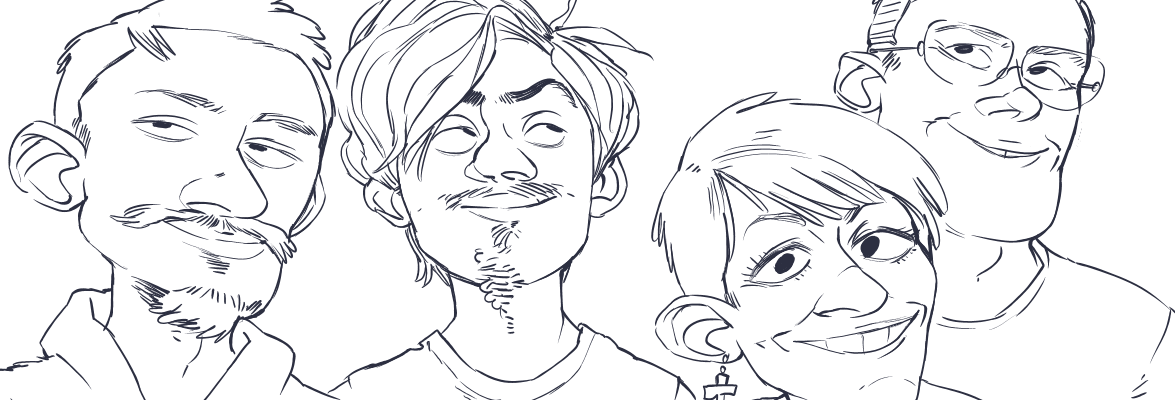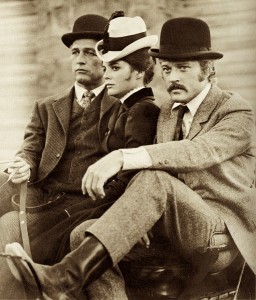The classic from 1969, Butch Cassidy and the Sundance Kid, holds up very well due to, I would say, a rock-solid Enneagram. The late-60s stylings feel, at this point in time, so retro they’re fresh.
In my earliest attempts at an Enneagram review I would insert clips from the movie to illustrate the different numbers. This movie would lend itself well to that as its Enneagram is so delineated. I don’t do clips anymore, so a brief description will have to suffice.
1
The credits, which split-screen with a sepia-toned fake movie, transition into the real movie, still in the beige. We think we’re about to see a bank robbery but the hardening of the target, with extra bolts at the window and a strong safe, is the point. Crime ain’t what it used to be. Our two characters are established, a touch of humor is thrown in, and we’re off.
2
Like clockwork the movie shifts to color. Butch and Sundance discuss the Trouble: where can they find a good robbery? Butch suggests Bolivia, which seems like a punchline at this point. To further the Trouble, Butch’s gang has made a rogue decision in his absence. After settling the leadership issue of the Hole in the Wall gang Butch takes the crew to rob a train. This leads to more Trouble, a posse formed specifically to track them down.
3
Sundance’s girlfriend Etta is introduced. This movie follows one of the go-to 3/6 formulas: Etta in/Etta out. The interesting twist is that Etta seems designed to lead the audience’s perceptions, not necessarily to further the characters’ choices. At first we think Etta is a sweet girl in danger of being raped by Sundance. It’s a gotcha. If I’m remembering correctly Butch was one of the first Westerns in which the leads were supposed to be likable bad guys. Etta is our guide; we take our emotional cues from her. These fellas may be robbers but they’re so sensitive and sweet! We can love them.
4
This section is the “who are those guys?” sequence. Butch and Sundance are chased by the posse all over the greater desert Southwest. Vast scenery, impressive camera work and the dread of inevitability are the watch words. A lot of this is played for humor, but one scene has the boys visit an old friend who is now a sheriff. He lays it out for them:
[quote]You should have let yourself get killed a long time ago when you had the chance. See, you may be the biggest thing that ever hit this area, but you’re still two-bit outlaws. I never met a soul more affable than you, Butch, or faster than the Kid, but you’re still nothing but two-bit outlaws on the dodge. It’s over, don’t you get that? Your times is over and you’re gonna die bloody, and all you can do is choose where.[/quote]
We the audience need this preparation. Butch and Sundance don’t seem affected by this speech, but we sense the foreshadowing.
SWITCH
Again, the filmmakers lay out an Enneagram map. Butch convinces Sundance to go to Bolivia, and Etta joins them. The movie switches (ahem!) to sepia-toned still shots of the three characters having a blast on their trip across country to New York and then on the steamer to South America.
An important note is Etta’s condition for going along: “I won’t watch you die.” Once more we have audience prep rather than any meaningful impact on the characters.
5
Like the 4, the 5 is one story arc: robbery in Bolivia. Much humor goes here, including the boys learning how to announce a robbery in Spanish and the “Ba Da Ba” (or whatever its name is) 4-part harmony song that overlays the montage. Butch and Sundance become famous, the “Bandidos Yanqui”, and their options become fewer. The guys’ attempt to go straight and protect a payroll shipment turns sour, which triggers the next sequence.
6
Our Enneagram goes a tiny bit fudgy here. The boys suggest that they have no options. Etta says, “What about farming or ranching?” and the boys shoot down her suggestions. We see her mind working. When she tells Sundance, “I think I’ll go home,” we know what that means.
The 6 and the 7 stack up on top of each other in terms of what the characters choose. The guys’ decision to return to crime will propel them into the 8. Etta’s leaving propels us into the 8. Later on, in the heart of 70s filmmaking, main characters die all the time. It’s a kind of hallmark of the era. At this point in the late 60s, though, the audience is new to the idea. We need to be prepared for tragedy. This 6 is for us. In a way, we now face the decision to go forward and watch the end of our heroes.
7
The actual decision and planning for the next, and final, job take place off screen. That’s ok. 7s do that sometimes. Etta’s gone, so we know the decision box has been checked.
8
The final shootout with Butch and Sundance against, unwittingly, the entire Bolivian army has become iconic. At the end, do the boys realize that they will die? We certainly do.
9
As the boys rush from cover, guns extended, the image freezes and goes to sepia-tone. The army’s gunfire is heard. Our knowledge of their death is the 9. I find this technique fascinating. The final number happens in our mind, like a Chinese martial arts battle. I also like the use of sepia at the 1 and 9 as the bookends.
I would argue that an Enneagram as regimented as this leads to a movie that becomes a classic people will endlessly rewatch. The handsome lead actors and the stylized photography, the witty dialogue and catchy soundtrack, are important, of course. The craft of this movie is simply excellent on all levels. However, I believe that its Enneagram backbone is the linchpin to this movie’s success. Pull out Butch any time you want to present the strength of what an Enneagram can do for your story.


Permalink
Damn your good.
I watched the same movie at the same time in the same room with you, (now its true that you have seen it more often than I), but I did not see it … I did not see the Enneagram. It’s not like I disagree with your take on it, or that I’m jealous you got there first (much 😉 ) its just the damnable fact that I did not see it until you revealed it too me. Its like … magic.
Movie Magic is an illusion. Story Enneagramming is the bringing of structure to an artform that relies on emotional trickery, on the illusion of meaning through the juxtaposition of images and sounds. To apply the Enneagram and better the illusion, the trick must be understood, to understand the trick, one must not fall prey to the illusion … therein lies the paradox. I am drawn into the illusion of Butch and cannot see how the trick was done and thereby render myself blind to its Enneagram.
Your vision is 20/20 on this one, nicely done, but be careful, the Magician’s Alliance has their eye on you!